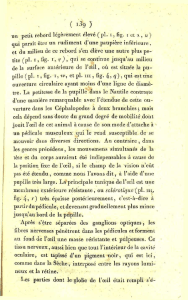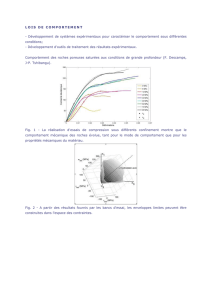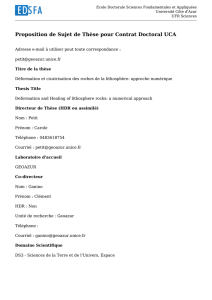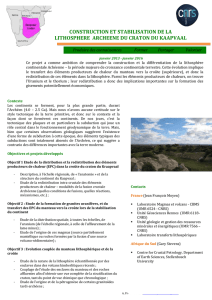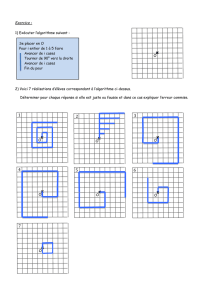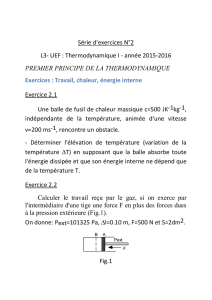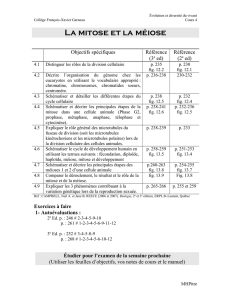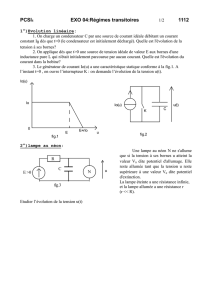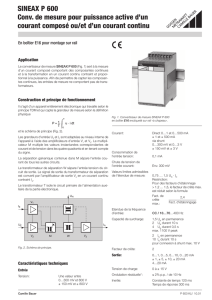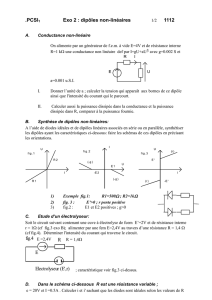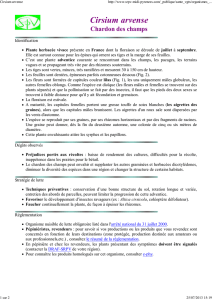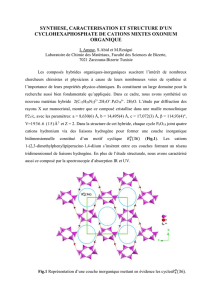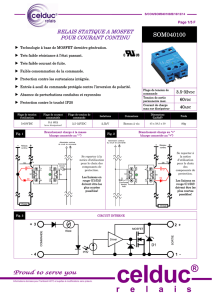La classe de première S La tectonique des plaques: une approche
publicité
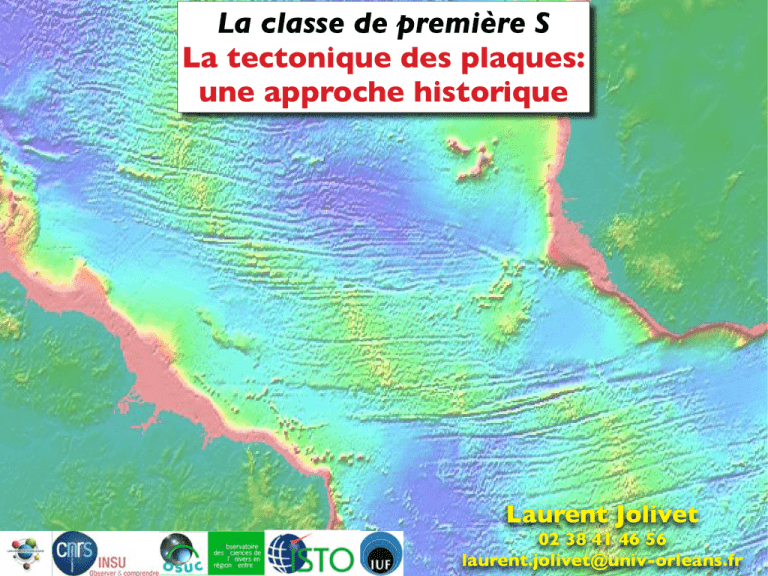
La classe de première S La tectonique des plaques: une approche historique Laurent Jolivet 02 38 41 46 56 [email protected] La classe de première S La tectonique des plaques: une approche historique Les grandes lignes de la tectonique des plaques ont été présentées au collège. Il s’agit, en s’appuyant sur une démarche historique, de comprendre comment ce modèle a peu à peu été construit au cours de l’histoire des sciences et de le compléter. On se limite à quelques étapes significatives de l’histoire de ce modèle. L’exemple de la tectonique des plaques fournit l’occasion de comprendre la notion de modèle scientifique et son mode d’élaboration. Il s’agit d’une construction intellectuelle hypothétique et modifiable. Au cours du temps, la communauté scientifique l’affine et le précise en le confrontant en permanence au réel. Il a une valeur prédictive et c’est souvent l’une de ces prédictions qui conduit à la recherche d’un fait nouveau qui, suivant qu’il est ou non découvert, conduit à étayer ou modifier le modèle. La solidité du modèle est peu à peu acquise par l’accumulation d’observations en accord avec lui. Les progrès techniques accompagnent le perfectionnement du modèle tout autant que les débats et controverses. La naissance de l’idée Au début du XXe les premières intuitions évoquant la mobilité horizontale s’appuient sur quelques constatations : - la distribution bimodale des altitudes (continents/océans), - les tracés des côtes, - la distribution géographique des paléoclimats et de certains fossiles. Ces idées se heurtent au constat d’un état solide de la quasi-totalité du globe terrestre établi, à la même époque, par les études sismiques. Elle est rejetée par une part importante de la communauté scientifique. Osmond Fisher (1817-1914) géologue britannique, tenant d’un modèle de Terre en refroidissement, note les similitudes de la forme des continents et propose qu’ils aient été autrefois réunis. Antonio Snider-Pellegrini, géographe français (1802-1885) propose une première reconstitution de la Pangée avant le modèle d’Alfred Wegener. Il avait trouvé des plantes fossiles datant du Carbonifère identiques de part et d’autre de l’Atlantique. Il pensait que le déluge biblique était la cause de la séparation des continents. Eduard Suess (1831-1914) Ce schéma est très moderne bien qu’E. Suess ait été un partisan de la contraction de la Terre (repris du cours de A.M.C. Sengör au Collège de France en 2005) Les géologues ne sont pas fixistes et la découverte des nappes de charriage (1884) est une grande avancée conceptuelle Bertrand, 1884 Peach & Horne, 1884 (Figures reprises du livre d’Olivier Merle - Masson, 1994) La réinterprétation de la tectonique des Alpes orientales par Pierre Termier en 1903 (repris du cours de A.M.C. Sengör au Collège de France en 2005) Carte des aires continentales par Emile Haug (1900). Prolongement des chaînes européennes sur le continent nord-américain selon Marcel Bertrand (1887). Les géologues pensent «global» mais ils manquent des concepts explicatifs (c’est l’époque du «géosynclinal») http://www2.ulg.ac.be/geolsed/geol_gen/geol_gen.htm planet-terre.ens-lyon.fr/planetterre/XML/db/p... F.B. Taylor 1910 Brève histoire de la mob de Wegener à Hess, Wegener utilise la distribution bimodale des altitudes pour argumenter la dichotomie continents-océans... Il parle de continents qui flottent sur un substratum visqueux. Il évoque aussi le problème des vitesses de déformation (la poix se casse mais elle flue quand on la laisse reposer...) Alfred Wegener: Die Entstehung der Kontinente (1912, 1915) Die Entstehung der Kontinente und Ozeane (1915, 1929) www.lhce.lu/Geologie/Option/derive.html www.lhce.lu/Geologie/Option/derive.html www.lhce.lu/Geologie/Option/derive.html planet-terre.ens-lyon.fr/planetterre/XML/db/p... Certains géologues sont très tôt «mobilistes» La continuité des structures géologiques d'un continent à l'autre selon Alexandre Du Toit (1927). La formation des montagnes par la collision de deux continents selon Emile Argand (1924). Ses visions sont prophétiques. planet-terre.ens-lyon.fr/planetterre/XML/db/p... Certains géologues sont très tôt «mobilistes» La continuité des structures géologiques d'un continent à l'autre selon Alexandre Du Toit (1927). La formation des montagnes par la collision de deux continents selon Emile Argand (1924). Ses visions sont prophétiques. planet-terre.ens-lyon.fr/planetterre/XML/db/p... Certains géologues sont très tôt «mobilistes» La continuité des structures géologiques d'un continent à l'autre selon Alexandre Du Toit (1927). La formation des montagnes par la collision de deux continents selon Emile Argand (1924). Ses visions sont prophétiques. L’évolution de la Méditerranée selon Emile Argand (1924) ! Les Alpes résultant de la collision de deux masses continentales Extension et océanisation en Méditerranée (Emile Argand) (Repris du séminaire de Jean-Paul Schaer au Collège de France en 2005) Mais la théorie de Wegener est très largement rejetée Le rejet de la théorie de Wegener Harold Jeffreys (1891-1989) Ce n’est qu’en 1922 que les géologues commencent à s’intéresser aux thèses de Wegener. Passée la réserve du début, les hostilités deviennent de plus en plus virulentes. Les détracteurs doutent du sérieux scientifique de Wegener et pour justifier leur rejet ils argumentent que les mesures géodésiques de l’éloignement du Groenland sont plus qu’incertaines, que les ajustements entre continents sont imprécis et sans doute accidentels, que les ressemblances géologiques et paléontologiques ne sont pas si évidentes et qu’il est bien téméraire de vouloir prouver l’existence d’un ancien continent unique en cherchant à raccorder les moraines glaciaires… Lake, en 1922, ouvre les hostilité contre la théorie Wegener, en mettant en doute le sérieux de sa démarche scientifique : « Wegener lui-même n'aide pas son lecteur à se faire un jugement impartial. Même si son attitude a pu être originale, dans son livre, il ne cherche pas la vérité, il défend une cause, et il ferme les yeux devant chaque fait et chaque argument qui la contredit » (in U. Marxin, Continental drift : Evolution of a concept, Washington, Smithsonian Institution Press, 1973, p. 83.) Et que se passe-t-il sur le fond des océans et avant les 200 derniers millions d’années ? Wegener n’en dit rien et ces deux lacunes ont certainement joué un grand rôle dans le rejet de sa théorie. Mais les détracteurs trouvent leurs objections les plus fortes dans le mécanisme invoqué pour rendre compte des mouvements : l’intensité des forces supposées est bien trop faible, la résistance du sima bien trop forte pour permettre un déplacement appréciable des continents. Le chef de fil des négateurs absolus est Harold Jeffreys (1891-1989). Il calcule que les forces supposées ont une amplitude 2,5.105 fois trop faible pour mouvoir et déformer les blocs continentaux et pour lui la théorie des translations est « out of the question ». planet-terre.ens-lyon.fr/planetterre/XML/db/p... In Holmes, 1929 Sir Arthur Holmes (1980-1965) est certainement le plus visionnaire des géologues mobilistes. Il a pressenti de nombreux concepts en vogue aujourd’hui Sir Arthur Holmes (1890-1965), the British geologist who contributed to our understanding of Earth's age. Photo courtesy of University of Edinburgh, Department of Geology and Geophysics http://www.amnh.org/education/resources/rfl/web/essaybooks/earth/p_holmes.html Chaleur de la Terre, convection et mouvements en surface, chaînes de montagnes... Arthur Holmes Radioactivity and Earth Movements (1931) Chaleur de la Terre, convection et mouvements en surface, chaînes de montagnes... Holmes 1931 Jean Goguel (1952 et 1962) 20 Jean Goguel (1952 et 1962) La solution viendra de la communauté des géophysiciens et de la découvert du domaine océanique 20 L’étude du magnétisme des roches a fait faire un saut en avant considérable 1853: Découverte de l’aimantation des roches: Macedonio Melloni 1901, 1906: Découverte des inversions par Bernard Bruhnes; premières datations des inversions par Matuyama 1952: Invention d’un magnétomètre capable de mesurer de très faibles champs magnétiques par Patrick Blackett 1959: Keith Runcorn et Ted Irving mesure la mémoire magnétique des roches, ils inventent le paléomagnétisme. 1960: John Reynolds et John Verhoogen confirment les observations de Matuyama sur les inversions 1960: Walter Elsasser et Ted Bullard développent l’idée de la dynamo terrestre 1960-1966: Etablissement de la première échelle des inversions du champs sur les derniers 4 Ma par Alan Cox, Richard Doell et Brent Dalrymple (US Geological Survey), et Ian McDougall et François Chamalun (Australian National University). Le !"#$%#&#$'()*+%,$) !"#$%&#'!"# $%&' paléomagnétisme a fourni les premières preuves indépendantes de la dérive des continents Keith Runcorn ($%'')$%%*+ pôle eulerien 88.5'N-27.7'E Ji Jim Jim Ts Ti Ps Amérique du Nord Europe Ts Ti Pi Ji Cs Ps Pi Cs Ds SsDi Ssm OmSi Ds Di Ps Ti $, Pi Ci Ci Di Ts Jim Ds OmSi Cs Ci Di Ssm OmSi SsDi Runcorn, S.K.: Palaeomagnetic evidence for continental drift and its geophysical cause, in S.K. Runconrn (ed) Continental Drift, New York, Academic Press, 1962 Courbes de dérive du pôle pour l'Europe et l'Amérique Ssm SsDi Actuel Reconstruction anté-ouverture de l'Atlantique La première échelle des inversions du champ magnétique a fourni la base de la théorie de l’expansion des fonds océaniques Allan Cox (seated), Richard Doell (L), and Brent Dalrymple (R) at a gas mass spectrometer. This photo was taken sometime in the early 1960s. Image courtesy of Stanford School of Earth Sciences. The first figure by Cox, Dalyrmple, and Doell shows Earth’s magnetic reversals and the beginnings of the Geomagnetic Polarity Time Scale. (mod. from Science, 1963) quake06.stanford.edu/centennial/tour/stop11.html www.ggl.ulaval.ca/.../s1/magnetisme.terr.html L’hypothèse de l’expansion océanique et sa vérification Au début des années 1960, les découvertes de la topographie océanique et des variations du flux thermique permettent d’imaginer une expansion océanique par accrétion de matériau remontant à l’axe des dorsales, conséquence d’une convection profonde. La mise en évidence de bandes d’anomalies magnétiques symétriques par rapport à l’axe des dorsales océaniques, corrélables avec les phénomènes d’inversion des pôles magnétiques (connus depuis le début du siècle) permet d’éprouver cette hypothèse et de calculer des vitesses d’expansion. ! Proposed that all sea floor is created and destroyed ! Used pattern of quakes " Quakes occur along plate boundaries 14 Maurice Ewing et le Vema eanography 102, Strickland/Nuwer Lecture 6 © 2009 University of Washington Mary Tharp et Bruce Heezen Marie Tharp & Bruce Heezen Découverte des dorsales médioocéaniques... Les campagnes océanographiques des années 50 ont permis la mise en évidence de montagnes sous la mer sur plus de 50 000 km. Chaque océan à la sienne. Atlantique - 5000 m Pacifique - 5000 m Harry Hess, 1962 Au départ l’expansion des fonds océaniques est une hypothèse formulée en particulier par Robert S. Dietz (1961) et Harry H. Hess (1962) BUDDINGTON VOLUME 603 HISTORY OF OCEAN BASINS CONTINENTAL COLUMN Krn OCEANIC COLUMN ! 9/( I I I - - :$:",+SEDIMENT - LAYER 3-SERPENTINE I LAYER 4 1 3.34 I 6 16 BUDDINGTON VOLUME Depth Sea Floor in Abyssal Areo in Km X 3 B BUDDINGTON VOLUME Figure 2. Balance of oceanic and 0, Figure 7. Diagram to represent (1) apparent progressive overlap of ocean sediments on a mid-ocean ridge which would actually be the effect of the n ~ a n t l cmoving laterally away from ridge crest, and (2) the postulated fracturing where convective flow changes direction from vertical to horizontal. Fracturing and higher temperature could account for the lower seismic velocities o n ridge crests, and cooling and healing of the fractures with time, the return to normal velocities on the flanks. =r a 5=r 0 -* 2 continental crustal columns 2 3 -. 3 3 HISTORY OF BASINS that basalt flows poured out on the ocean floor could be so uniform in thickness. Crr 0 0 Rather, one would expect them to be thick near the fissures or vents from which 3 g they were erupted and thin or absent at great distance from the vents. T h e only 2 a likely manner in which a layer of uniform thickness could be formed would be if g' r a its bottom represented a present or past isotherm, at which temperature and L Figure 9. Diagram to show progressive migration of volcanic peaks, guyots, and atolls, from pressure a reaction occurred. Two such reactions can be suggested: (1) CORE the basalt a ridge crest to the flanks. suggesting that the wave-cut surfaces of guyots or the bases of atolls may become older laterally away from the crest to eclogite inversion (Sumner, 1954; Kennedy, 1959), and (2) the hydration of : 11. Graph portraying depth to the hl discontinuity under continents us. dep abyssal areas in oceans, computed from balance of crustal columns sidence compared to present topographic ridges could be explained by the above olivine to serpentine at about 500°C (Hess, 1954). T h e comnlon Figure 8. Possibleoccurrence geometry of a mantle of convection cell reasoning. peridotitic inclusions in oceanic basaltic volcanic rocks (Ross, Foster, and Myers, Turning to a reconsideration of the Mid-Atlantic Ridge it appears that layer old ridge (Fig. 9). On this basis it would be very interesting to examine the fauna 3, with a thin and probably discontinuous cover of sediments, forms the sea 1954) and absence of eclogite inclusions lead the writer to northern acceptmargin postulate (2).or to drill atolls near on guyots near the of the old ridge the floor. T h e dredging of serpentinized peridotite from fault scarps at three places southern margin to see if the truncated surfaces or bases have a Triassic or even on the ridge (Shand, 1949) points to such a conclusion. T h e abnormally lo~v Furthermore, the dredging of serpentinized peridotites from scarps the Permian age. At any ratefault the greater width in of the old ridge and its belt of subseismic velocity, if this is layer 3, might be attributed to intense fracturing and oceans (Shand, 19-19)? where the displacement on the faults may have been dilation where the convective flow changes direction from vertical to horizontal. Figure 7. Diagram to represent (1) apparent progressive overlap of ocean sediments on T h e underlying material, which ordinarily would have a velocity of 8 km/sec or sufficient expose layer to this supposition. This choice of a mid-ocean ridgeto which would actually be the 3, effectadds of the ncredence ~ a n t l cmoving laterally away 12. Diagram illustrale tliicLe~ling of a continent by tlcfor~nation. 1niti;lll) ;I Fig~ilcmore, has ato velocity approximately 7.4 kmlsec partly for the same reason but from ridge crest, and (2) the postulated fracturing where convective flow changes direction ~ n obecause u ~ l t a isystem n of its andabnormally much larger root aretemperature formed, but both spread postulates is made here and will control much of the subsequent reasoning. T h e also high (Fig. 7). T h e interface between from vertical to horizontal. Fracturing and higher temperature could account for the lower time and isostatic adjustment layer 3 and laterally the 7.4with km/sec material below is thus the hI discontinuity. T h e inseismic velocities o n ridge crests, and cooling and healing of the fractures with time, the seismic velocity of layer 3 is highly variable; it ranges from 6.0 to 6.9 km/sec and return to normal velocities on the flanks. crease in velocity of layer 3 to about 6.7 km/sec and of the sub-bIoho material to OCEAN km of water and equate this to continental columns for the same pressure at 40 L’introduction du terme «sea-floor spreading» par l’océanographe américain Robert S. Dietz (1914-1995) en 1961 (repris du cours de C. Sengör au Collège de France en 2005) La découverte des anomalies magnétiques par Raff et Mason (1961) puis leur interprétation indépendamment par L. Morley et Vine & Matthews fournissent des preuves de la réalité de ce processus !"#$%&%'())*$+, -./0 © 1963 Nature Publishing Group Lawrence W. Morley Matthews, Vine et McKenzie Il faut attendre la publication du «magic profile» pour que l’ensemble des géophysiciens soit convaincu 21 20 19 Routes du navire océanographique Eltanin en 1960 (Columbia University) pour enregistrer les variations du champ magnétique Profil magnétique enregistré par l’Eltanin la ligne rouge représente l’absence d’anomalie Anomalie magnétique, nT profondeur, km Extrait d’un cours de Cornell Univ. Pitman et Heirtzler, 1966 ESE WNW WNW ESE total intensity anomaly calculated from model image miroir du profil pour montrer la symétrie profil mesuré la symétrie du profil Eltanin 19 Extrait d’un cours de Cornell Univ. Pitman et Heirtzler, 1966 ESE WNW WNW ESE total intensity anomaly calculated from model image miroir du profil pour montrer la symétrie profil mesuré la symétrie du profil Eltanin 19 Extrait d’un cours de Cornell Univ. Pitman et Heirtzler, 1966 JOURNALOF GEOPHYSICAL R•-S•-AaC• VOL. 73, No. 6, MARCH 15, 1968 Marine Magnetic Anomalies,GeomagneticField Reversals, and Motions of the Ocean Floor and Continents J. R. HEIRTZLER, 2 G. O. DICKSON,E. M. I-IERRON, W. C. PITMAN,III, ANDX. LE PICHON3 Lamont GeologicalObservatory, Columbia University Palisades,New York 10964 INTRODUCTION HERRON, o PITMAN, •o www-istp.gsfc.nasa.gov/earthmag/mill_6.htm DICKSON, Carte des anomalies magnétiques su sud de l’Islande [Heirtzler, 1968] o AND LE PICHON are the mo,deI blocks, derived for the North Pacific profile and adjusted to fit the other The three previouspapersof this series[Pito.ceans.The North Pacific profile is a c,omposite man et al., 1968; Dickson et al., 196.8; Le using sectionsat differen,tlatitudes becauseof Pichon and Heirtzler, 19'68] have shown that complexstructure. a magnetic anomaly pattern, parallel to and It is our purpose in this paper to derive a bilaterally symmetric about the mid-oceanic time scalefor the sequenceof magneticpolarity ridge system, exists over extensiveregions of even'rspredicted by the basic model and to the North Pacific,South Pacific,SouthAtlantic, discussthe conceptso.f continental drift. and and Indian oceans. It has been further demono,ceanfloor spreadingin terms of the anomaly strated that the pattern is the same in each pattern and the time scale. of these oceanic areas and that the pattern FollowingVine and Matthews [1963], we will may be simulatedin each region by the same assumethat all the linear magnetic anomalies, sequenceof source blocks. These blocks comsu'b-parallelto the ridge axis, are due to geoprise a series of alternate strips of normally magneticfield reversals.If that theory is b.asiand reversely magnetizedmaterial, presumably cally in error, the conclusions in this paper do basalt (Figure 1). not apply. Yet, if that theory is applied careThe symmetric and parallel nature of the fully, many geophysicalan'dgeologicalobserv'aan'omalypattern and the general configuration tions, previously thought to be unrelated or of the crustal model conform to that pre'dicted casuallyrelated,are seento have a simpleuniby Vi.r•eand Matthews [1963] and may be re- fied explanation. •arded as strong support for the concept of C•o•cE OF TX•E SCALE oceanfloor spreading[Dietz, 1961; Hess,1962]. Figure 1 sh,ows sampleanomalypro,fliesfrom The most obvi'ousmethod for deriving a t,hevariousregionsunder discussion. Alsoshown HEIRTZLER, Gondwanaland. 2124 This paper summarizesthe results of the three previous papers in this series, which have shown the presence of a pattern of magnetic anomalies, bilaterally symmetric about the crest of the ridge in the Pacific, Atlantic, and Indian oceans.By assumingthat the pattern is causedby a sequenceof normally and reversely magnetized blocks that have been produced by sea floor spreading at the axes of the ridges, it is shown that the sequencesof blocks correspondto the same geomagnetictime scale.An attempt is made to determine the absolute ages of this time scale using palcomagnetic and paleontological data. The pattern of opening of the oceansis discussedand the implications on continental drift are considered.This pattern is in good agreement with continental drift, in particular with the history of the break up of • 0 Mesure de la vitesse d’ouverture océanique 35 Extrait d’un cours de Cornell Univ. d’après Bott, 1967, 1982; dans Keary et al., Global tectonics, Blackwell, 2009 Les concepts de lithosphère et d’asthénosphère Au voisinage des fosses océaniques, la distribution spatiale des foyers des séismes en fonction de leur profondeur s’établit selon un plan incliné. Les différences de vitesse des ondes sismiques qui se propagent le long de ce plan, par rapport à celles qui s’en écartent, permettent de distinguer : la lithosphère de l’asthénosphère. L’interprétation de ces données sismiques permet ainsi de montrer que la lithosphère s’enfonce dans le manteau au niveau des fosses dites de subduction. La limite inférieure de la lithosphère correspond généralement à l’isotherme 1300°C. En observant les mouvements verticaux liés à la vidange du Lac Bonneville, Grove Gilbert discute en 1890 la notion d’isostasie et propose de substituer à l’isostasie locale (voir les théories de Pratt et Airy) la notion d’isostasie régionale impliquant o.une WOLV rigidité de la croûté. pensation tatic equiusly, such ew of the and rede- ve Gilbert which he h the geoure is that ust, which more local al Society (Gilbert, ons of the these may gidity and s, and valrigidity of plateaus, f isostatic as to den- f the crust ds. As an arance of ose abanhortly beupdoming (Fig. 3), e of the ake. Using of a solid \ \ La notion de «lithosphère», au sens d’une enveloppe rigide dotée d’une certaine élasticité, vient des études des mouvements verticaux C H A N G I N G ROLE OF LITHOSPHERE IN MODELS OF G L A C I A L ISOSTASY \ / \ V/ I." I :~ / / I c Seo level d e f / ' / / . / . ~ /~/., ~\\\\\\\\\\\\~ ~'," "/Regional Lithosphere compensati.or~\\~l ~ Depth of compensation ~sthenosphere~-- Fig. 4. Barrell's (1919b) conception of regional isostatic equilibrium versus conventional conception of local isostatic equilibrium. ~ Fig..3. Gilbert's (1890a) contour neville shorelines. On the other hand, Barrell regarded the asEn 1914 Joseph Barrell introduit la notion thenoshere as a plastic shell with the capacity to d’asthénosphère qu’il oppose à la lithosphère yield to long-enduring stress differences and, thus, rigide. L’asthénosphère est capable de se déformer adjustment. Commenting on to effect isostatic plastiquement pour effectuer les ajustements glacial isostasy, he isostatiques. took a more conservative view and remarked (Barrell, 1914a): 2 0 '~li,tts "It is not known, however, to what degree the map of warped Lake Bonprevious [before deglaciation] downwarp compen(D’après Wolf, 1993) sated for the burden of the continental ice sheet Fig. to ic pub yield to long-enduring stress differences and, thus, Commenting on to effect isostatic adjustment. glacial isostasy, he took a more conservative view and remarked (Barrell, 1914a): "It is not known, however, to what degree the previous [before deglaciation] downwarp compenCe type d’analyse est for étendu au cas des sated the burden of the continental ice sheet réajustements post-glaciaires and what degree of regional stress the crust was (Nansen,able 1921; 1934) toDaly, bear." Notwithstanding this cautionary note, Barrell's studies seem to have been generally well-received I A L ISOSTASY by the proponents of glacial isostasy. 99 Several years later, the Norwegian oceanograe f pher and polar researcher Fridtjof Nansen, in a comprehensive study of the glacial record preserved in Fennoscandia and elsewhere, developed a comparatively detailed model of glacial-isostatic adjustment (Nansen, 1921, pp. 290-306) and displayed its essential features in a simple illustration (Fig. 5). In another study of the properties and behaviour of the earth's crust and its substrac equitum, he remarked (Nansen, 1928, pp. 11-12): c equi"The earth's crust may ... be considered as a slowly flexible sheet of solid rock floating on a viscous substratum. If loaded in one place this sheet will bend slowly under the load, and the e asplastic matter underneath will be displaced to the ty to sides, where the sheet will be slightly lifted in a thus, belt round the depressed area. If unloaded in one g on place the sheet will rise slowly in that area; there be illustration an inward of flow in the of substratum view Fig. 5. Nansen'swill (1921) depression crust due underneath, and response a slight subsidence the sheet in the to ice-sheet. Note retarded of crust and of substratum. surrounding area." e the A major proponent of Barrell's work was the mpenNorth American geologist Reginald Daly, who sheet La notionFig.de «lithosphère», au sens 5. Nansen's (1921) illustration of depression of crust due to ice-sheet. Note retarded response of crust and substratum. d’une enveloppe rigide dotée d’une certaine élasticité, vient des études des published extensively on the Pleistocene. His mouvements verticaux views are summarized in a monograph, which (D’après Wolf, published extensively on the Pleistocene. His1993) also considers most of the work completed by other investigators up to that time. In particular, Daly discussed two alternative hypotheses of glacial-isostatic adjustment. To one of them he referred as bulge hypothesis (Fig. 6) and remarked (Daly, 1934, p. 120): "Below it [the flexible crust] is a weak substrat u m . . . According to the bulge hypothesis, the basining [of the crust] is accompanied by outward, horizontal flow in the substratum and just beneath the crust . . . . Because the substratum is 1i:!:?:.:!:::i::.:!:~i:!:::i:i:!!:i.::! ! ! i:! !.Zi:?:!:.c~:!.i:~ !:!:i i:~:!:?i:!:!:!.i.!:Z:Z:!.i..!:!.!:!:i:!:! SUBSTRATUM B' B' ' . ~ ~:':'.:::'.:::--'-" :'.'.-'.'j: 2 :':..-'.5...:...'"".': ................ .~):v.~.::~:::.::~?:.E::......j.:.~:::::_........... .....:':" . ...... t3" E~' 3 :::.:.:.:::::.:.5::::-:::::-.-. "~..:'":F:.'::::%'.:.'(-. ".~-'.-".~'.:.".'-~.:.:.'.'-'.'.-:.:.'..'.'.:.:-:." .. :.:.::,-.-..... :-...... ..... B" B'" Fig. 6. Daly's (1934) illustration of bulge hypothesis of isostatic adjustment. Note movement of peripheral bulge. yield to long-enduring stress differences and, thus, Commenting on to effect isostatic adjustment. glacial isostasy, he took a more conservative view and remarked (Barrell, 1914a): "It is not known, however, to what degree the previous [before deglaciation] downwarp compenCe type d’analyse est for étendu au cas des sated the burden of the continental ice sheet réajustements post-glaciaires and what degree of regional stress the crust was (Nansen,able 1921; 1934) toDaly, bear." Notwithstanding this cautionary note, Barrell's studies seem to have been generally well-received I A L ISOSTASY by the proponents of glacial isostasy. 99 Several years later, the Norwegian oceanograe f pher and polar researcher Fridtjof Nansen, in a comprehensive study of the glacial record preserved in Fennoscandia and elsewhere, developed a comparatively detailed model of glacial-isostatic adjustment (Nansen, 1921, pp. 290-306) and displayed its essential features in a simple illustration (Fig. 5). In another study of the properties and behaviour of the earth's crust and its substrac equitum, he remarked (Nansen, 1928, pp. 11-12): c equi"The earth's crust may ... be considered as a slowly flexible sheet of solid rock floating on a viscous substratum. If loaded in one place this sheet will bend slowly under the load, and the e asplastic matter underneath will be displaced to the ty to sides, where the sheet will be slightly lifted in a thus, belt round the depressed area. If unloaded in one g on place the sheet will rise slowly in that area; there be illustration an inward of flow in the of substratum view Fig. 5. Nansen'swill (1921) depression crust due underneath, and response a slight subsidence the sheet in the to ice-sheet. Note retarded of crust and of substratum. surrounding area." e the A major proponent of Barrell's work was the mpenNorth American geologist Reginald Daly, who sheet La notionFig.de «lithosphère», au sens 5. Nansen's (1921) illustration of depression of crust due to ice-sheet. Note retarded response of crust and substratum. d’une enveloppe rigide dotée d’une certaine élasticité, vient des études des published extensively on the Pleistocene. His mouvements verticaux views are summarized in a monograph, which (D’après Wolf, published extensively on the Pleistocene. His1993) also considers most of the work completed by other investigators up to that time. In particular, Daly discussed two alternative hypotheses of glacial-isostatic adjustment. To one of them he Les travaux ont permis la referred as plus bulgerécents hypothesis (Fig. 6)d’estimer and remarked 21 viscosités respectives (Daly, 1934, p. 120):de la lithosphère (~10 Pa.s) et de "Below l’asthénosphère (1-2 ordres plus crust] de is agrandeur weak substrait [the flexible faible) ainsi que les épaisseurs de la lithosphère t u m . . . According to the bulge hypothesis, the à plusis de 200 km) by outward, basining [of(de the50crust] accompanied horizontal flow in the substratum and just beneath the crust . . . . Because the substratum is 1i:!:?:.:!:::i::.:!:~i:!:::i:i:!!:i.::! ! ! i:! !.Zi:?:!:.c~:!.i:~ !:!:i i:~:!:?i:!:!:!.i.!:Z:Z:!.i..!:!.!:!:i:!:! SUBSTRATUM B' B' ' . ~ ~:':'.:::'.:::--'-" :'.'.-'.'j: 2 :':..-'.5...:...'"".': ................ .~):v.~.::~:::.::~?:.E::......j.:.~:::::_........... .....:':" . ...... t3" E~' 3 :::.:.:.:::::.:.5::::-:::::-.-. "~..:'":F:.'::::%'.:.'(-. ".~-'.-".~'.:.".'-~.:.:.'.'-'.'.-:.:.'..'.'.:.:-:." .. :.:.::,-.-..... :-...... ..... B" B'" Fig. 6. Daly's (1934) illustration of bulge hypothesis of isostatic adjustment. Note movement of peripheral bulge. mediate and deep earthquakes were attributed to body waves. Wadati sought to apply this diagram to the estimation of the scale of destructive earthquakes. This diagram could be compared with Richter's magnitude-scale, published in 1935. 4. Wadati's fourth paper Honda tried to analyse the P-wave radiation pattern of the intermediate and deep earthquakes, and published a paper on the mechanism of deep earthquakes in 1934, in which he discussed the spatial distribution of forty-five deep earthquakes deeper than 100 km that occurred between 1927 and 1933. He pointed out that they took place along the Principal (Wadati's Transverse) deep earthquake zone, crossing central Honshu NNW-SSE, and the Soya deep earth- Une autre approche de la lithosphère au travers de la subduction Wadati published his fourth paper in 1935, in which the frequency-distribution of earthquakes occurring between 1924 and 1934, and the contour lines of equal focal depths of intermediate and deepearthquakes, were plotted. They revealed inclined surfaces dipping away from the oceanic trenches—the planes that came in the West to be called the Benioff Zones following Benioff's publication in 1955. The name was subsequently changed to Wadati-Benioff Zones, thus acknowledging their discovery by Wadati two decades earlier. Lines of equal focal depth Hypocentres of 42 deep earthquakes between 1905 and 1923, and 62 deep and 28 intermediate earthquakes between 1924 and April 1934 were plotted, showing the frequency distribution of their focal depths and their geographical distributions. The data before and after 1924 were shown separately, as the seismological observatories were better equipped with Wiechert seismographs and offered more reliable data after 1924. The data indicated the most frequent occurrences were at depths of 300 to 400 km and the least were at about 200 km. Eight earthquakes were deeper than 500 km, and the deepest was at 660 km. Most of the deep earthquakes occurred along the Transverse and Soya deep-focus earthquake zones. The former zone extended over 2000 km from Vladivostok to the Bonin Islands, traversing central Honshu. The latter one ran northeast along the Chishima Islands, extending from the northern part of the Sea of Japan through the Strait of Soya (La Pèrouse). In addition to those zones, the Kyushu deep earthquake zone was revealed near the Ryukyu Islands, extending to northern Kyushu. Based on the depth of the hypocentres of these earthquakes, the lines of equal focal depth were shown, at which intermediate and deep earthquakes occurred frequently ( Figure 3). The lines ran along the Chishima (Kurile) Islands, Hokkaido, northeast Honshu, and the IzuBonin Islands, and dipped away from the Chishima, Japan and Izu-Ogasawara trenches towards the north, west, and southwest. Other lines ran along the Ryukyu Islands and got deeper from the Ryukyu trench toward WNW. Benioff, 1955 Wadati, 1935 Figure 3 Distribution of earthquakes and lines of equal focal depth for intermediate and deep earthquakes (Wadati, 1935). H. P. Berlage, 1937: Les isobathes des tremblements de terre de l’Asie du sud-est. (repris du cours de C. Sengör au Collège de France en 2005) ties involved, coincidewith the low Q zone of other important quantities to determine. The continuity immediately suggestsa structural the highInQfact, zonethe of configuration Figure 13 does data from this paper provide limited informathe anomalous zone are different fromFigure those 13. of If relation. of Figure JOURNALOF GEOPtlYSICAL RESEARCI-I VOL. 72,13 NO. 16 AUGUST 15, 1967 indeed represent the lithosphere, a with layer tion on this point; consequently, the configucouldclearly be reconciled an of underthrustwaves traversing more normal parts of the ration of the 'anomalous zone' is not well designificant then it or is settling apparent mantle, and, less certainly, becausethe veloci- strength, ing, or dragging, of that the uppermost theories of tectonics based on outward convection fined. mantle layer on the sidecurof the arc be- Early in the investigationit appeared ties of P and S waves appear to be high in the that the anomalous zone coincided with the zone. rents must take this into Such account, for its neath thelayer arc itself. a process is in general zone of seismic Structures loci. When the most recent data Deep Earthquake Zones, effects on surface geology could be large and Anomalous From this point it is a minor and reasonably agreement with the hypotheses relating to seaspreading under the in influence mantle varied. Such a layer, when involved exten- ofand safe step to explain the pertinent character of floor in the Upper Mantle, * communication)are of L.the R. Lithosphere Sykes (personal the seismic waves as an effect of attenuation convection currents, as proposed Hess sion, thrusting, or flexing, could introduce great byconsidered, however,it appearsthat the seismic OLIVER AND BRYAN ISACKS along all, or a substantialpart, of thecomplexity propaga- into [1962], [1961], and others. These hy-which the Dietz effects of JACK a driving force zone, was thought to be 50 to 100 km in for rising convection currents betion path. When this is done, the of anomalous relativelypotheses simple call configuration and hence thickness, may, in the caseof the deep shocks Lamont Geological Observatory, Columbia University zone is found to be a region of low attenuation neath the ocean ridges and sinking currents in help to explain how complex surface geology of the Tongan arc, be lessthan 20 km in thickPalisades, New York 10964 might result from a driving mechanism,say, a ness.The zone of high Q, i.e., the anomalous TONGA convection current, conclusion of greaterofsimplicity. although not well because of unThe principal this paperThe is thatzone, regional seismic data fordefined deep and shallow I '• TRENCH concepts of lithosphere, asthenosphere, and certainties earthquakes associatedwith the Tonga-Kermadec arc show there exists in theand mantle inthat hypocentral locations velocity an anomalous whose thickness is ofones the order of 100 km and whose upper surface is mesosphere are, ofzone course, long standing structures, appears, on the basis of various ray proximately defined by the highly active seismic zone that dips to the west beneath the in geology[Daly, 1940] and need not be elabo- path locations,to be somewhatthicker, perisland arcQand extends to depths of about 700 km. Limited data for other areas suggestthat LOW ratedsimilar here. 'anomalous The new feature of associated this paper is other haps of the order 100important km. The evidence data further LO",N Q zones' are with island arcs. The of most 200configuration km the evidence that conclusion suggestsaisnew suggest that the Sloci are located nearin thethe upper for the above that seismicbody waves, particularly waves, propagating anomalous zones much to attenuation than are waves of the same type propafor, and perhaps theare extent ofless thesubject mobility of, boundary of the anomalous zone, i.e., near the gating in parts of the mantle at similar depthsupper elsewhere. Oneofinterpretation of the above the lithosphere. surface the lithosphere. This is also HIGH O results and of some additional seismic data is that the deep anomalous zone is continuous H•GHQ The conceptof a lithosphere that large the region in which crustal materials would be HIGH Q covers with the uppermost mantle east of Tonga. Such a structure is consistentwith theories of found if they werearcs. carried into the partsmantle of theTonga, earth's surface yet isbased discontinuous convection with down-going currents in this the vicinity of island If low down attenuation Fig. 13. Hypothetical sectionthrough Fiji, snd Rarotonga on data of mantle. Thus, the presence such materials of seismic waves with strength, this be structure suggests that the of lithosphere has in and, tolow a certain degree, mobile (perhaps driven paper. Boundaries between high Q and Q zones are correlates not well determined but can ticularly of the S wave, propagating through HIGH• I taken as a first approximation. been thrust or dragged down beneath the Tonga arc and hence implies a certain mobility for the lithosphereelsewhere.This possibility suggests,in turn, new approachesto a wide variety of problems ranging from theTONGA nature of the earthquake mechanismto the relation between complex surface mechanismswhose configuration ß geology and '.. driving ...... R•Rmay 0 be relatively simple. .... ..." "?'..".?-'"."':": .... ' ' •½:i!iii!::" ...... :'":':':::::: ".........•:i:!:i::'ASTHENOSPHERE The evidencecomeslargely from the seismic The purpose of this paper •:i:i:i:' is to demonstrate waves that are generated by deep shocksand that zonesof the upper mantle associatedwith that travel through different zones en route to different recording stations. The evidence is deep earthquakesare anomalous,i.e., that cer-MESOSPHERE largelyand qualitative, but it is not and it Fig. 14. of Hypothetical section Fiji, Tonga, Rarotonga, assuming Q subtle correlates tain properties these zones differ through from those definitive. new structure a part with of strength. The lithosphere and mesosphere zones ofThis significant strength,for and the of. of parts the mantle at comparable depths isare the upper mantle is important becauseis of its asthenosphere is a zone of vanishingstrength on appropriate time scale. The terminology elsewhere. Seismologists commonly use the term that of Daly [1940]. 'deepearthquake' in two s•nses. In the stricter relation to theoriesof focal mechanismsof deep shocks,to theoriesof the spatial and temporal INTRODUCTION 3.:::::::' ties involved, coincidewith the low Q zone of other important quantities to determine. The continuity immediately suggestsa structural the highInQfact, zonethe of configuration Figure 13 does data from this paper provide limited informathe anomalous zone are different fromFigure those 13. of If relation. of Figure JOURNALOF GEOPtlYSICAL RESEARCI-I VOL. 72,13 NO. 16 AUGUST 15, 1967 indeed represent the lithosphere, a with layer tion on this point; consequently, the configucouldclearly be reconciled an of underthrustwaves traversing more normal parts of the ration of the 'anomalous zone' is not well designificant then it or is settling apparent mantle, and, less certainly, becausethe veloci- strength, ing, or dragging, of that the uppermost theories of tectonics based on outward convection fined. mantle layer on the sidecurof the arc be- Early in the investigationit appeared ties of P and S waves appear to be high in the that the anomalous zone coincided with the zone. rents must take this into Such account, for its neath thelayer arc itself. a process is in general zone of seismic Structures loci. When the most recent data Deep Earthquake Zones, effects on surface geology could be large and Anomalous From this point it is a minor and reasonably agreement with the hypotheses relating to seaspreading under the in influence mantle varied. Such a layer, when involved exten- ofand safe step to explain the pertinent character of floor in the Upper Mantle, * communication)are of L.the R. Lithosphere Sykes (personal the seismic waves as an effect of attenuation convection currents, as proposed Hess sion, thrusting, or flexing, could introduce great byconsidered, however,it appearsthat the seismic OLIVER AND BRYAN ISACKS along all, or a substantialpart, of thecomplexity propaga- into [1962], [1961], and others. These hy-which the Dietz effects of JACK a driving force zone, was thought to be 50 to 100 km in for rising convection currents betion path. When this is done, the of anomalous relativelypotheses simple call configuration and hence thickness, may, in the caseof the deep shocks Lamont Geological Observatory, Columbia University zone is found to be a region of low attenuation neath the ocean ridges and sinking currents in help to explain how complex surface geology of the Tongan arc, be lessthan 20 km in thickPalisades, New York 10964 might result from a driving mechanism,say, a ness.The zone of high Q, i.e., the anomalous TONGA convection current, conclusion of greaterofsimplicity. although not well because of unThe principal this paperThe is thatzone, regional seismic data fordefined deep and shallow I '• TRENCH concepts of lithosphere, asthenosphere, and certainties earthquakes associatedwith the Tonga-Kermadec arc show there exists in theand mantle inthat hypocentral locations velocity an anomalous whose thickness is ofones the order of 100 km and whose upper surface is mesosphere are, ofzone course, long standing structures, appears, on the basis of various ray proximately defined by the highly active seismic zone that dips to the west beneath the in geology[Daly, 1940] and need not be elabo- path locations,to be somewhatthicker, perisland arcQand extends to depths of about 700 km. Limited data for other areas suggestthat LOW ratedsimilar here. 'anomalous The new feature of associated this paper is other haps of the order 100important km. The evidence data further LO",N Q zones' are with island arcs. The of most 200configuration km the evidence that conclusion suggestsaisnew suggest that the Sloci are located nearin thethe upper for the above that seismicbody waves, particularly waves, propagating anomalous zones much to attenuation than are waves of the same type propafor, and perhaps theare extent ofless thesubject mobility of, boundary of the anomalous zone, i.e., near the gating in parts of the mantle at similar depthsupper elsewhere. Oneofinterpretation of the above the lithosphere. surface the lithosphere. This is also HIGH O results and of some additional seismic data is that the deep anomalous zone is continuous H•GHQ The conceptof a lithosphere that large the region in which crustal materials would be HIGH Q covers with the uppermost mantle east of Tonga. Such a structure is consistentwith theories of found if they werearcs. carried into the partsmantle of theTonga, earth's surface yet isbased discontinuous convection with down-going currents in this the vicinity of island If low down attenuation Fig. 13. Hypothetical sectionthrough Fiji, snd Rarotonga on data of mantle. Thus, the presence such materials of seismic waves with strength, this be structure suggests that the of lithosphere has in and, tolow a certain degree, mobile (perhaps driven paper. Boundaries between high Q and Q zones are correlates not well determined but can ticularly of the S wave, propagating through HIGH• I taken as a first approximation. been thrust or dragged down beneath the Tonga arc and hence implies a certain mobility for the lithosphereelsewhere.This possibility suggests,in turn, new approachesto a wide variety of problems ranging from theTONGA nature of the earthquake mechanismto the relation between complex surface mechanismswhose configuration ß geology and '.. driving ...... R•Rmay 0 be relatively simple. .... ..." "?'..".?-'"."':": .... ' ' •½:i!iii!::" ...... :'":':':::::: ".........•:i:!:i::'ASTHENOSPHERE The evidencecomeslargely from the seismic The purpose of this paper •:i:i:i:' is to demonstrate waves that are generated by deep shocksand that zonesof the upper mantle associatedwith that travel through different zones en route to different recording stations. The evidence is deep earthquakesare anomalous,i.e., that cer-MESOSPHERE largelyand qualitative, but it is not and it Fig. 14. of Hypothetical section Fiji, Tonga, Rarotonga, assuming Q subtle correlates tain properties these zones differ through from those definitive. new structure a part with of strength. The lithosphere and mesosphere zones ofThis significant strength,for and the of. of parts the mantle at comparable depths isare the upper mantle is important becauseis of its asthenosphere is a zone of vanishingstrength on appropriate time scale. The terminology elsewhere. Seismologists commonly use the term that of Daly [1940]. 'deepearthquake' in two s•nses. In the stricter relation to theoriesof focal mechanismsof deep shocks,to theoriesof the spatial and temporal INTRODUCTION 3.:::::::' Zhao, 2004 Une dernière approche de la lithosphère au travers du flux de chaleur L. Fleitout Un premier modèle global: une lithosphère découpée en plaques rigides A la fin des années soixante, la géométrie des failles transformantes océaniques permet de proposer un modèle en plaques rigides. Des travaux complémentaires parachèvent l’établissement de la théorie de la tectonique des plaques en montrant que les mouvements divergents (dorsales), décrochants (failles transformantes) et convergents (zones de subduction) sont cohérents avec ce modèle géométrique. Des alignements volcaniques, situés en domaine océanique ou continental, dont la position ne correspond pas à des frontières de plaques, sont la trace du déplacement de plaques lithosphériques au dessus d’un point chaud fixe, en première approximation, dans le manteau. © 1965 Nature Publishing Group J.T. Wilson introduit la notion de faille transformante et invente la tectonique des plaques Wilson, 1965 Nature Publishing Group Wilson, 1965 cinématique à deux plaques Quelles données ? LA ZONE SEISMIQUJE MEDIANE INDO-ATLANTIQIUE BY J. P. ROTHE' Professeur a 1'Universite de Strasbourg, Directeur du Bureau international de Setismologie 0 0 co*0 0f t c t, p 388 C _ a tkjk . _ _ 0~~~~~~~~~~~~0 The distribution of earthquake epicentres in the Atlantic and Indian Oceans is discussed; numerous new epicentres are listed. It is shown that the line of epicentres following the midAtlantic Ridge is continued round the Cape of Good Hope and joins the similar line marking the central ridge of the Indian Ocean. It seems, therefore, that these two ridges are related structures. 6RXUFH3URFHHGLQJVRIWKH5R\DO6RFLHW\RI/RQGRQ6HULHV$0DWKHPDWLFDODQG3K\VLFDO 6FLHQFHV9RO1R$'LVFXVVLRQRQWKH)ORRURIWKH$WODQWLF2FHDQ0DU Introduction SS 3XEOLVKHGE\The Royal Society deviennent de plus en plus nombreuses et grac determinations d'epicentres Les a l'installation de nouvelles stations munies d'appareils modernes la position et l forme des zones seismiques oceaniques se precisent chaque annee davantage. L rC t,i"7 F-In qffitt-I 0a --t 1 _t - 0 - 0_ r0. _ /@ g t BM,_ _s a/ 0 -~ ! M-l - 0 t K {---M (4) J. P. Rothe (Discussion Meeting) t0 t -~ ~~~~~~,4)- _ 0 44 i l r---t ' ,( 0<_ __ - - k ._ I 1 11 ___ < 0 50 ;* i <J e 0 Les limites de plaques la sismicité est localisée le long de ceintures étroites (ici les séismes de magnitude > 5.5) Les limites de plaques la sismicité est localisée le long de ceintures étroites (ici les séismes de magnitude > 4.5) Les vitesses relatives: les anomalies magnétiques Les directions des mouvements relatifs: les mécanismes au foyer des séismes Les directions des mouvements relatifs: les mécanismes au foyer des séismes Les directions des mouvements relatifs: les failles transformantes Les failles transformantes sont parallèles au mouvement relatif Les failles transformantes sont parallèles au mouvement relatif Les failles transformantes sont parallèles au mouvement relatif cinématique à deux plaques La géométrie eulérienne JOURNAL OFGEOPHYSICAL RESEARCH VOL. 72, No. 8 APRIL 15, 1967 Mechanismof EarthquakesandNatureof Faultingon the Mid-OceanicRidges LYNN 1•. SYKES Institute [or Earth Sciences, ESSA,Lamont GeologicalObservatory,ColumbiaUniversity 2133 OF EARTHQUAKES Palisades, New York ed t The mechanisms of 17 earthquakeson the mid-oceanicridgesand their continentalextent sionswereinvestigatedusingdata from the World-WideStandardized Seismograph Network a of the U.S. Coastand GeodeticSurveyand from otherlong-period seismograph instruments. DEXTRAL SINISTRAL Mechanism solutions of highprecision cannowbe obtainedfor a large numberof earthquakes _100 • TRANSFORM FAULTS iwith magnitudesas small as 6 in many areasof the world. Lessthan 1% of the data usedin k. this studyare inconsistent with a quadrantdistributionof first motionsof the phasesP and t PKP; in many previous investigations15 to 20% of the data were often inconsistentwith the publishedsolutions.Ten of the earthquakesthat were studied occurredon fracture zonesthat intersect the crest of the mid-oceanicridge. The mechanismof each of the shocksthat is e. t locatedon a fracturezone is characterized by a predominance of strike-slipmotion on a SINISTRAL DEXTRAL steeplydippingplane;the strikeof oneof the nodalplanesfor P wavesis nearlycoincident TRANSCURRENT FAULTS with the strike of the fracture zone. The se. nse of strike-slipmotion in each of the ten soluFig. 1. Sense of motion associated with transr tionsis in agreement with that predictedfor transformfaults; it is oppositeto that expected form faults and transcurrent faults [after Wilson, for a simpleoffsetof the ridge crestalongthe variousfracturezones.The spatial distribue 1965a]. Double line representscrest of mid-oceanic tion of earthquakes alongfracturezonesalsoseemsto rule out the hypothesis of simpleoffset. is ridge; single line, fracture zone. The terms 'dex•:o ø,8:84øE ½: I0ø, 8=90ø • ---•36ø N 79 ø S Fig. 6. Mechanismsolution for event 2. Table I and Figures 3 and 4 give epicentral and other pertinent data. Symbolssame as Figure 5. and 'sinistral' describe the Two well documented solutionsfor earthquakes that are locatedon the mid-Atlanticridge but that by a predominance transform faultsdo not appearto be locatedon fracturezonesare characterized sense of motion e of the fracture zones; for the of faulting. The mechanismsof four earthquakes on extensionsof the mid-oceanic of normal se they do not denote the relative configuration the two segments of ridge on either side of system---one the ridge near northernSiberiaand three in East Africa--are alsocharacterized by t fracture zone. er e MECHANISM OF EARTHQUAKES tral' Fig. 8. Mechanismsolution for event 4. Table I and l•igures 3 and 4 contain position and other pertinentdata. SymbolssameasFigure 5. a predominanceof normal faulting. The inferred axes of maximum tension for these six events are approximatelyperpendicularto the strike of the mid-oceanicridge system.The resultsare in agreement of sea-floorgrowthat the crestof the mid-oceanic ridgesystem. other pertinent data are listed in Table 1. ReL. Sykes propose le premier test with hypotheses 1965, 1966; Heezen and Tharp, 1961, 1965a] fault displacements as great as 1000km IVacquiet, 1962; Menard,1965]. sev59 Nevertheless, eral probIemsare raisedabout interpretations of this type. The inferredmagnitudeand sense 2137 liable solutionsprobably could be obtainedfor earthquakes on the middes idées de Wilson t several additional INTRODUCTION e oceanicridges, the west Chile and Macquarie sur les failles transformantes exic ridges,and the seismicallyactive zone The that discovery of a large number of fracture - tends from the Azores to Gibraltar. However, zoneson with the exceptionof one earthquake onthe themid-oceanicridges [Menard, 1955, JOURNAL OFGEOPHYSICAL RESEARCH VOL. 73, No. 6, MARCH15, 1968 Rises,Trenches,GreatFaults,andCrustalBlocks Time W. JASON MORGAN Time 2 I Time Department o• Geolo.gy,Princeton University, Princeton, New Jersey08540 Fig. 3. Three crustalblocksboundedby a rise, trench,and faults are shownat three and Department o• Geology and Geophysics, Woods Hole Oceanographic Institution successive timeintervals. Note the motion of the fourcircular markersplaced on the ridge 1962 Woods Massachusetts 02543 cres•atW.time the solidHole, segments showthe motion o,fthesecircles;the dottedsegments show JASON1: MORGAN the originalcoordinates of thesemarkers.The strikeof a transform fault is parallelto the Morgan montre pour la difference of the velocities of the twosides;the crestJ. of the ridgedrifts with a velocity that •J RISES, TRENCtIES, The transformisfault concept is extended a two spherical the average of the velocities oftothe sides. surface.The earth's surfaceis considered to be made of a number of rigid crustal blocks. Itpremière is assumed each block is foisthat la réalité de la boundedby rises (where new surfaceis formed), trenchesor young fold mountains(where vector average of the of the two géométrie enparallel petit cercle des of the be to the or difference surfaceis being destroyed), andvelocities great faults, andsides. that there isfault no must stretching, folding, dis- in Note thatwithin the two faults extending velocity of the sides.Thus, allblock the faults tortion of any, kind a transform given block. On a spherical surface, thetwo motion of one failles transformantes et propose to theseby two ablocks must of lie one on small into block 2 on the left are not parallel. (over the mantle) relative to another block mayAll thencommon be described rotation north of theblock. trenchThis (between blocksrequires 1 and circles concentric the pole of relative la notion deabout pôle de rotation block relativefaults to the other rotation three parameters, two to locate theetmo2) wouldrun eastto,westas the oneshown,and ron. pole GREAT FAULTS, AND CRUSTAL BLOCKS 1965 of relative rotation and one to specify the magnitude of the angular velocity. If two adde blocs rigides. Ilfaults délimite des faults of the trench (between blocks The velocity block relative to another jacent blocksall have as south common boundaries a number of great faults, allofofone these must lie 2latitude' and 3) would have 45ø strike as shown. An will along their boundary; about theapole of relative rotation. Thevary velocity of onecommon block relative to this plaques rigides • ,/// on / 'circlesof example of where the strike of transform faults commonboundary; this velocity wo•uldhave a maximumat Time I must vary along Time their 2 Time • //// the' other 60 60 60 changes in this manner offrelative the coast of the 'equator' vanish attrench, aoccurs pole of rotation. Fig. 3. Threeand crustalwould blocksbounded by a rise, and faults are shownat three Mexico at, intersection of markers the Middle Amersuccessive timeintervals. Note thethe motion of the fourto circular placed on the ridge The motion of Africa relative South America is a case for which enough data are availcres•at time 1: the solidsegments showthe motiono,fthesecircles;the dottedsegments show -/, / / 60 ica trench, the The East Pacific rise, and thetoGulf coordinates oftest thesemarkers. strike of a transform fault is parallel the ablethe tooriginal critically this hypothesis. The many offsets on the mid-Atlantic ridge appear to difference of the velocities of the twosides;the crestof the ridgedriftswith a velocitythat k_' is the average of of the California. velocities of the two sides. be compatible with a pole of relative rotation at 62øN (___5ø),36øW (___2ø).The velocity We go tochoice a sphere. theorem of geompattern predictednow by this of Apole roughly agreeswith the spreadingvelocitiesdetervector average of the velocities of the two sides. of the fault must be parallel to the differencein etry states that, a block on a sphere can be moved mined magnetic anomalies. motion ofall the Pacific block relative to North America Note thatfrom the two transform faults extending velocityThe of the two sides.Thus, the faults ./ /. 30 these two blocksby must on small block 2 on theto leftany are not parallel. All common to other conceivable orientation a liesingle isinto also examined. The strike of faults from the Gulf of California to Alaska and the angles faultsnorth of the trench (betweenblocks1 and circlesconcentricabout the pole of relativemo- 30 ron. b ': ß o 0 •0 a properly chosen axis.both We imply a pole of relative rotation at 2) wouldrun east to,rotation westearthquake as the oneabout shown,andmechanism inferred from solutions all faults south of the trench (between blocks velocity ofthat one block relative to another use thisastheorem toThespreading prove relative 53øN ofthe the Pacific-Antarctic ridge showsthe best agree2 and 3) (_3ø), would have a53øW 45ø strike (___5ø). shown.An The will vary along their common boundary; this example of where themotion strike of transform faultsrigid blocks on a sphere may of two ment with this hypothesis. The Antarctic block is found to be moving relative to the Pacific changesin this manner occursoff the coast of be described by an velocity Mexico at,about the intersection the Middle block a ofpole at Amer71øS angular (___2ø), 118øE vector (_5 ø)bywith a maximum spreading rate of 5.7 •0 ica trench, the Eastusing Pacificrise, and the Gulf three parameters, two to specifythe loca(___0.2) of California. cm/yr. An estimateof the motion of the Antarctic block relative to Africa is made tion the one for the magnitude of now go to a sphere. Aof theorem geom-and byWeassuming closure ofofpole the Africa-America-Pacific-Antarctica-Africa circuit and summingthe etry statesthat,a block on a angular spherecanbevelocity. moved the Consider the left block in three angular velocity for the casesabove. to any other conceivable orientationbyvectors a single 0 • Figure 4 to be stationaryand the right block to Fig. 4. On a sphere, the motion of block 2 be moving as shown.Fault lines of great disrelative to block I must be a rotation about some component of pole.isAllthe boundary trench at between whichIcrustal faults on the type boundary and 2 velocity perpendicularto their strike; the strike must be small circlesconcentricabout the pole A. rotation about a properly chosen axis. We 30 use0 this theorem to prove that the relative motion of two rigid blocks on a sphere may (a) (b) be describedby an angular velocity vector bywhere there is no placement occur INTRODUCTION Fig. 8. Great circlesperpendicularto the strike of offsetsof the mid-Atlantic ridgeusing are three parameters,two to specifythe locashownin (a). With one exception,all of these lines passwithin the circle centeredat 58øN, tion of the pole and one for the magnitude of 36øW. Great circlesperpendicularto the strike determinedby earthquakemechanismsolutions are shown in (b). the angular velocity. Considerthe left block in 30 60 30 0 30 60 ...... 30 A geometricalframeworkwith which to de- surfaceis beingdestroyed;that is, the distance Variation de la vitesse d’ouverture en fonction de la distance au pôle de rotation (Westphal et al., 2003) Variation de la vitesse d’ouverture en fonction de la distance au pôle de rotation •Vitesse maximale à 90° du pôle de rotation (Westphal et al., 2003) Variation de la vitesse d’ouverture en fonction de la distance au pôle de rotation •Vitesse maximale à 90° du pôle de rotation •Variation en sinus de la distance angulaire (Westphal et al., 2003) D. McKenzie et R.L. Parker testent également de leur côté les hypothèses de Wilson avec des blocs rigides. © 1967 Nature Publishing Group cinématique à trois plaques Les points triples Les points triples A B C B A C B A C B A C A V B/A C B A B V B/A V C/B C A B V B/A V C/B V A/C C A B V B/A V C/B V A/C C Triangle des vitesses Points triples et rigidité JONCTION TRIPLE DE TROIS RIDES (RRR) R AB R AB B A A P V AC V BA B P V CB C C R CA R BC REPRESENTATION CARTOGRAPHIQUE •La R BC R CA ESPACE DES VITESSES rigidité impose que vAC + vBA + vCB = 0 •Or v = ω ∧ r •Donc ωAC + ωBA + ωCB = 0 78 T. Atwater: http://www.geol.ucsb.edu/Outreach/Download/Freeware-FR.html T. Atwater: http://www.geol.ucsb.edu/Outreach/Download/Freeware-FR.html cinématique à n plaques Les modèles globaux •'OURNALOF GEOPHYSICAL RESEARCH X. Le Pichon propose le premier modèle global quantifié en vitesses et directions de mouvement VOL. 73. NO. 12. JuN•- 15. 1968 Sea-FloorSpreadingand ContinentalDrift XAvI•,• L•, PICHON 2 Lamont Geological Observatory, Columbia University Palisades, New York 10962 A geometricalmodel of the surfaceof the earth is obtained in terms of rigid blocks in relative motion with respectto each other. With this model a simplifiedbut completeand consistentpicture of the global pattern of surfacemotion is given on the basisof data on sea-floorspreading.In particular,the vectorsof differentialmovementin the 'compressire' belts are computed.An attemptis madeto usethis modelto obtain a reconstruction of the historyof spreadingduringthe Cenozoicera. This history of spreadingfollowscloselyone previouslyadvocatedto explainthe distributionof sedimentsin the oceans. I. INTRODUCTION ized belts of deformation. Recent studies of the and of the distribution of sediments in the o o o o o • o o ,..c:• o,..Q o o• of the African or South American continents. Motion of the African relative to the South 3675 paper we try to carry this attempt further and to test whether the more uniformly distributed data on sea-floorspreadingnow available are DRIFT this CONTINENTAL -- ments of ocean floor and continents. In AND oceans [Ewing and Ewing, 1964] did not reveal widespreadindicationsof compressionor distortionof large oceanicblocks.Consequently, the displacementsinferred in the spreadingfloor hypothesis of Hess [1962] and Dietz [1961] shouldnot result in large-scaledeformation of the moving blocks.Morgan [1968] has investigatedthe important implicationsof these observationson the geometry of the displace- SPREADING physiographyof the oceanfloor [Heezen,1962] SEA-FLOOR It haslong beenrecognizedthat if continents are beingdisplacedon the surfaceof the earth, these displacementsshould not in general involve large-scaledistortions,exceptalonglocal- Let us assumethat largeblocksof the earth's surface undergo displacementsand that the only modificationsof the blocks occur along some or all of their boundaries,that is, the crests of the mid-oceanridges, where crustal material may be added, and their associated transform faults, and the active trenchesand regionsof active folding or thrusting, where crustalmaterial may be lost or shortened.Then the relative displacementof any block with respectto another is a rotation on the spherical surface of the earth. For example, if the Atlantic Ocean is opening along the mid-Atlantic ridge, the movement should occur in such a way as not to deform or distort the large bodiesof horizontallystratifiedsediments lying in its basinsand at the continentalmargins.It shouldnot involvelarge-scaledistortion American block (one block including the con- 3'OURNAL OF GEOPHYSICAL RESEARCH Isacks, Oliver et Sykes montrent que les observations des sismologues confortent le modèle de la tectonique des plaques VOL. 75, NO. 18, SEPTEMBER 15, 1968 Seismologyand the New Global Tectonics BRYAN ISACKS AND JACK OLIVER Lamont GeologicalObservatory,Columbia University, Palisades,New York 10964 LYNN R. SYKES u Earth Sciences Laboratories, ESSA Lamont GeologicalObservatory,Columbia University,Palisades,New York 10964 A comprehensive study of the observationsof seismologyprovideswidely basedstrong support for the new global tectonicswhich is founded on the hypthesesof continental drift, sea-floorspreading,transform faults, and underthrustingof the lithosphereat island arcs. Althoughfurther developments will be requiredto explaincertainpart of the seismological data, at presentwithin the entire field of seismologythere appearto be no seriousobstacles to the new tectonics.Seismicphenomenaare generallyexplainedas the result of interactions and other processes at or near the edgesof a few large mobileplatesof lithospherethat spread i.' SEISMOLOGY AND NEW GLOBAL TECTONICS o N W apart at the ocean ridgeswhere new surficial materials arise, slide past one another along the large strike-slip faults, and convergeat the island arcs and arc-like structureswhere surficial AND NEW GLOBAL materials descend.Study of world seismicity showsthatSEISMOLOGY most earthquakes areTECTONICS confinedto narrow continuousbelts that bound large stable areas.In the zonesof divergenceand strike-slip motion, the activity is moderate and shallow and consistent with the transform fault hypothesis; in the zones of convergence,activity is normally at shallow depths and includes intermediate and deep shocksthat grosslydefine the present configuration of the down-going slabs of lithosphere.Seismicdata on focal mechanismsgive the relative direction of motion of adjoining plates of lithosphere throughout the active belts. The focal mechanismsof about a 5857 ITHOSPHER 5861 hundred widely distributed shocks give relative motions that agree with A $ T H E remarkably N 0 S P well H E Le Pichon's simplified model in which relative motions of six large, rigid blocks of lithosphere covering the entire earth were determined from M F' S magnetic 0 S and P topographic H E R data E associatedwith the zonesof divergence.In the zones of convergence the seismic data provide Fig. 1. Block diagramillustratingschematically the configurations and rolesof the lithosphere,asthenosphere, and mesosphere in a versionof the new globaltectonicsin whichthe the only geophysicalinformation on such movements. lithosphere, a layer of strength,plays a key role. Arrowson lithosphereindicaterelative movements oœadjoining blocks. Arrowsin asthenosphere possible compensating Two principal types of mechanismsare found for shallow earthquakes inrepresent island arcs: The flow in response to downward movementof segments of lithosphere. Onearc-to-arctransformfault extremely active zone of seismicity under theappears inner margin of thefacing ocean is characterized at left betweenoppositely zonestrench of convergence (islandarcs),two ridge-toridgetransformfaults alongoceanridgeat center,simplearc structureat right. by a predominance of thrust faulting, which is interpreted as the relative motion of two converging plates of lithosphere; a less active zonethe in lithosphere the trench andsettled, on beneath the outer an islandwall arc or aof continental strike-slip faults) is disconmargin that is currently active. At an tinuous; elsewhere it is continuous. Thus, the the trench is characterizedby normal faulting and is thought to be a surficial manifestation of inactive lithosphere is composedof relatively thin margin the lithospherewould be unbrokenor the abrupt bending of the down-goingslab of lithosphere. structures along theshowstwo The left side of the diagram blocks, some of enormoussize,Graben-like which in the healed. island-arc structures, back to back, first approximation be considered infinitely outer walls of trenchesmay provide a mechanism formay including and transportingsedimentstowith the 5874 SEISMOLOGY AND NEW GLOBAL TECTONICS ISACKS, OLIVER, AND SYKES 5871 0 • ,,/ 5878 ISACKS, OLIVER, TRENCH•AXIS ti th Volcanic Coralline Arc Arc 0 Water ß•:.:::• , • 1.1..%1 :. ß. 5 '":' "::.....: h ]0 I I :(:'":':':•:': ::"" Depth, km 0 Dislance -400 from KM + 200 Niumate, Tonga, -200 200 o/ km 0 Fig. 14a. Length l is a measureof the amount of underthrustingduring the most recent period of sea-floor spreading. + 200 o in -o si 6oo Iy / / / , mechanism that could indicate extension instead of compressionparallel to the dip of the zone. / 400 55O / ' 6 600 km 6OO , - •50 • - •00 2oo I,• • Fig. 11. Vertical sectionsperpendicularto the strike of an island arc showingschematically Fig. 14b. Lithosphere is deformed along its typical orientations of double-couplefocal mechanisms.The horizontal scale is the same as lower edge as it encountersa more resistant layer the vertical scale. The axis of compressionis represented by a converging pair of arrows; the (the mesosphere). axis of tension is representedby a diverging pair; the null axis is perpendicular to the section. In the circular blowups, the senseof motion is shown for both of the two possible slip planes.The featuresshownin the main part of the figure are based on resultsfrom the Tonga arc and the arcs of the North Pacific. The insert showsthe orientation of a focal 200 E - 250 km Alternatively,Isacks and Sykes [1968] show would, therefore, be expected, especiallynear that, if it is assumedthat the slip planesform parts of the zone with complex structure. The important feature of the interpretation at angleswith respectto the axis of maximum compressive stressthat are not significantly presented here is that the deep earthquake NEWinterpreGLOBAL TECTONICS mechanisms reflect 5869 stresses in the relativelyFig. 14c. Length of seismiczone is the product differentfrom 45ø, SEISMOLOGY then a veryAND simple of rate of underthrusting and time constant for tation can be made on the basis of the model strong slab of lithosphere and do not directly assimilation of slab by upper mantle. 550km 300 250 200 150 I00 5O 0 50 I00 km the shearing motions parallel to of Figure 1. In this interpretationthe axis of accommodate LOCAL of the slab as is implied by the maximumcompressive stressis parallel to the the motion TENSION simple fault-zone model. The shearingdeformadip of the seismiczone (i.e., parallel to the CRUST S S CRUS tions parallel to the motion of the slab are prepresumed motion of the slab in the mantle), LITHOand the axis of least compressivestressis persumablyaccommodated by flow or creepin the SPHERE P HERE $ ductile parts of the mantle. pendicularto the zoneor parallelto the thin 0 adjoining dimension of the slab. Do the stressesin the slab vary with depth? The tendencyfor the compressire axesto be In particular, the axis of least compressive more stable than the other two axes can be stress,the T axis, may be parallel to the dip //////////// ASTHENOSPHERE the zone if the material at greater depths ,ß , of •$THENOSPHERE interpreted to indicatethat the difference between the intermediate and the least principal were sinking and pulling shallowerparts of theFig. 14d. A piece (or pieces) of the lithosphere becomes detached either by gravitational sinking stressesis less than the differencebetween the slab [Elsasset,1967]. In the Tonga, Aleutian, Fig. 7a. or by forcesin the asthenosphere. greatestandthe intermediate principalstresses. and Japanesearcs,the focal mechanismsindicate that is under compression parallel to its In general, the stress be quite 50 km :500 250 state 200 may150 I00 vari50 0 the slab 50 IOOkm depths greater than about 75 to 100 able owingto contortions of the slab,as sug- dip at allLOCAL Figure 14 shows four possible configurations of TENSION arcs, therefore, any extension in underthrust plate of lithosphere in island arcs. gestedby Figure9. Possiblylargevariability km. In these an be shallower than 75 to 100 kin. in the orientations ofS the mechanisms Solid areas indicates lithosphere; white area, • deep CRUST S S the slab must CRUST, ß Fig. 9. Vertical section oriented perpendicularto the Tonga arc. Circles represent earthquakesprojected from within 0 to 150 km north of the section; trianglescorrespondto events projectedfrom within 0 to 150 km south of the section.All shocksoccurredduring 1965while the Lamont network .of stations in Tonga and Fiji was in operation. Locations are based on data from these stations and from more distant stations.[No microearthquakesfrom a sample of ?50 events originated from within the hatched region near the station at [Niumate, Tonga (i.e., for $-P times less than 6.5 sec). A vertical exaggerationof about 13:1 was used for the insert showingthe topography [after Raitt et al., 1955]; the horizontal and vertical scalesare equal in the crosssection depicting earthquake locations. Lower insert shows enlargement of southern half of section for depths between 500 and 625 km. [Note small thickness (less than •20 km) of seismiczone for wide range of depths. ß ß ß ß ß ß ß ß asthenosphere;hatched area, mesosphere. L I T H 0 S P HERE Leur article est plein d’idées nouvelles très à la mode aujourd’hui sur la dynamique de la subduction sp an n it th o th ti an LOCAL TENSION (• $ P HE Isacks et al., 1968 "••'"" ASTHENOSPHERE ASTHENOSPHERE 15( km Fig. 7b. Figure 7 showsvertical sectionsthroughan islandarc indicatinghypotheticalstructuresand other features.Both sectionsshow down-goingslab of lithosphere,seismiczone near surface of slaband in adjacentcrust,tensionalfeaturesbeneathoceandeepwhereslabbendsabruptly and surfaceis free. (In both sections,S indicatesseismicactivity.) (a) A gap in mantle portion of lithosphere beneath island arc and circulation in mantle associatedwith crustal material of the slab and with adjoining mantle [Holmes, 1965]. (b) The overridinglithospherein contact with the down-goingslab and bent upward as a result of overthrusting.The relation of the bending to the volcanoesfollows Gunn [ 1947]. No vertical exaggeration. d d th an T e m s m c n th d p e d an th c w p tr a is ep tw q am [H ea Z pi is m co flysch accumulations thickening toward the trench, and blueschistm61anges.As the oceanic Jou•N^L os G•O?H¾SICaL RESE^I•CI• plate descendsbeneath the continental rise to depthsgreaterthan 100 km, submarinevolcanics are erupted behind the volcanicfront (Figure untain belt is schematically illustrated in gure 10. These sequencesare based on an alysis [Bird and Dewey, 1970] of northstern parts of the Appalachiansfor Ordovin times and on the general structure of the sozoic Cordilleran system along the western CONTINENTAL SHELF • CONTINENTAL RISE .......... •--'"'---...• - 10A). As the heat flux generatedby the rise of volcanic front • pillow lavas turbld•tes-] sealevelI argllle scaghose volcan,cs / i ..... :•L • If '•/. /t •x • • I • i / •/• VOL. 75, NO. 14, MAY 10, 1970 argillites ••nat• Mountain Belts and the New Jo• • Global Tectonics F. D•w•v m •/ •x/ x•/• /• •. _• / /, fl:•_, • .• flysch IIIIIIIil111111111 •xl x -- I•/ /•/x. • • ,- •/.... i,,.1,•.. Department o• Geology, University of Cambridge Cambridge, England • flysch s•a I' • ""/ ., \-. -.•.- ..... • • / C- / ' • _xx.- -•.-/-',%%/•-.... x•. •.x x•/•/ ...... / ' x%./,<.•- . .... JOHN M. -- '/ •J'I andg•nod•orites l i' I I'1•'-•,•!•1•I I I I I I I • Jmetamorph•c front Department of Geological Sciences State University of New York at Albany Albany, New York 12203 thermal doming/granites w I grawty slide / wlldflysch - ••j_'•__•__•' •.7•.-/ •--•..•"•--•• BIRD I sealevel 2642 DEWEY AND BIRD Analysis of the sedimentary, volcanic, structural, and metamorphicchronologyin mountain -- x x •' basalticand andesitic volcanoes belts, and considerationof the implicationsof the new global tectonics (plate tectonics), spread,ng • K•O•. ..... e.s ing.r'•nlt•s // I undertucking offlysch rafts I• molasse "•_•.=•' '..•.--.----•2 • ½• . J . , orogcn on conbncntal dcformabon of sediments at stronglyindicate of plate evolution.It is proposed marginthat mountainbelts are a consequence • flysch wedge /footofinner wall oftrench lubtes / • •-•. I develop/by the z deformationand metamorphism a,nd cherts continental that mountainxbelts of the shelf sedimentaryand volcanic assemblagesof Atlantic-type continental margins. These assemblagesresult from the events associated with the rupture of continents and the expansionof oceans by • bluesch•st • metamorp ß- '/ ' x','x- , J' a••c Ik"--T•'gh urn•__n.a tholeiibk: '! lithosphereplate generation at oceanic ridges. The earliest assemblagesthus developed • andes•tesand rhyohtes are volcanic rocks and coarseclastic sedimentsdepositedin fault-boundedtroughs on a distendingand segmentingcontinentalcrust,subsequentlysplit apart and carried away from -'•... • '- ' .• •.•>-• •_ •_ •, ,', •.. andto•,te, the ridge on essentiallyaseismiccontinentalmargins.As the continentalmarginsmove away thrust wedges of crust , oceanic crust shelf delta from the ridge,Bnonvolcanic continental and rise assemblagesof oceanic orthoquartzite-carbonate, and lutite (shelf), and lutite, slump deposits, and turbidites (rise) This ' crustaccumulate. .hthosphere plate kind of continental margin is transformedinto an orogenicbelt in one of two ways. If a trench develops near, or at, the continenal margin to consumelithosphere from the oceanic Fig. 10. Schematicsequenceof sectionsillustrating a model for the evolution of a cordillerana mountain belt (cordilleran type) grows by dominantly thermal mechanismsrelated type mountainbelt developedby the underthrusting of a continentby an side, oceanicplate. to the rise of calc-alkaline and basaltic magmas. Cordilleran-type mountain belts are characw•de zone of shallow earthquakes terized by paired metamorphic belts (blueschiston the oceanic side and high temperature on the continental side) and divergent thrusting and synorogenicsediment transport from La nouvelle théorie est très vite the high-temperaturevolcanic axis. If the continental margin collideswith an island arc, or with another continent, a collision-type mountain belt develops by dominantly mechanical •l•r i i .•J•.' • I I I •, \ ea level . h•u ß • cent oran•te plutons mise à profit par les géologues. processes.Where a continent/island are collision occurs, the resulting mountains will be small (e.g., the Tertiary fold belt of northern New Guinea), and a new trench will develop Ils tiennent enfin le cadre on the oceanic side of the arc. Where a continent/continent collision occurs,the mountains conceptuel qui leur manquait et will be large (e.g., the Himalayas), and the single trench zone of plate consumptionis replaced by a wide zone of deformation. Collision-type mountain belts do not have paired qui est venu des océans metamorphic belts; they are characterizedby a single dominant direction of thrusting and synorogenic Fig. sediment transport, sequence away from the siteillustrating of the trench over theofunderthrust 13. Schematic of sections the collision two continents. plate. Stratigraphic sequencesof mountain belts (geosynclinal sequences) match those as- Le modèle NUVEL-1 (DeMets et al., 1990) Le modèle NUVEL-1 (DeMets et al., 1990) NB: tous les mouvements sont par rapport à l’Eurasie fixe Le renforcement du modèle par son efficacité prédictive Le modèle prévoit que la croûte océanique est d’autant plus vieille qu’on s’éloigne de la dorsale. Les âges des sédiments en contact avec le plancher océanique (programme de forage sous-marins J.O.I.D.E.S.) confirment cette prédiction et les vitesses prévues par le modèle de la tectonique des plaques. Le modèle prévoit des vitesses de déplacements des plaques (d’après le paléomagnétisme et les alignements de volcans intraplaques). Avec l’utilisation des techniques de positionnement par satellites (G.P.S.), à la fin du XXe siècle, les mouvements des plaques deviennent directement observables et leurs vitesses sont confirmées. carte des anomalies magnétiques sites de forage du programme DSDP Dès le début les idées sur l’expansion des fonds océaniques sont testées par des forages. C’est le programme DSDP Extrait d’un cours de Cornell Univ. anomalie magnétique Forages profonds dans l’Atlantique (DSDP) âge paléontologique âge du fond de l’océan donné par les fossiles trouvés dans les sédiments déposés directement sur la croûte océanique en fonction de l’âge des anomalies Extrait d’un cours de Cornell Univ. Age (Ma) des anomalies en supposant une vitesse constante L’âge du fonds des océans Müller et al. 1997 demi-vitesses d’ouverture Volcanisme de dorsale Pillow-lavas (laves en coussins) Les campagnes de plongée montrent la réalité du volcanisme des dorsales, puis des déformations dans les fosses de subduction Le système GPS Satellite Antenne Récepteur Beaucoup plus récemment les mesures des déformations et des déplacements de la croûte sont grâce aux méthodes géodésiques (GPS...) Sites de mesures géodésiques Réseaux GPS régionaux (une cinquantaine, près de 3000 sites) Réseau GPS global (>150) Réseau VLBI global [Ma & Ryan, 1998] (70 sites) Réseau DORIS [Crétaux et al., 1998] (in Kreemer, 2002) On observe une coincidence presque parfaite entre les vitesses prédites par la cinématique des plaques «classique» et les vitesses mesurées directement par géodésie. Vitesses mesurées vs. prédites SLR+VLBI (Robbins et al., 1993) DORIS (Soudarin, 1994) Vitesses mesurées par géodésie comparées aux vitesses prédites par le modèle « géologique » NUVEL-1 Dans les zones de limites de plaques on peut mesurer la déformation des continents Dans les zones de limites de plaques on peut mesurer la déformation des continents Frontières de plaques C. Kreemer Frontières de plaques C. Kreemer Les limites de plaques sont des zones de largeur finie, au sein desquelles se produisent des déformations. Prise en compte de la déformation interne des frontières de plaques (Kreemer et al., 2002) Le plus bel exemple est sans conteste la déformation de la lithosphère asiatique sous la poussée de l’Inde Tapponnier et Molnar, 1977 cinématique absolue Les points chauds, passage de la cinématique à la dynamique Le modèle NUVEL-1 (DeMets et al., 1990) NB: tous les mouvements sont par rapport à l’Eurasie fixe Le modèle NUVEL-1 (DeMets et al., 1990) cinématique relative NB: tous les mouvements sont par rapport à l’Eurasie fixe Le modèle NUVEL-1 (DeMets et al., 1990) cinématique relative Quid des mouvements /manteau profond ? NB: tous les mouvements sont par rapport à l’Eurasie fixe Wilson, 1963 Les premières idées sur les relations entre convection, tectonique des plaques et ce qu’on appelle aujourd’hui les points chauds ont été proposées très tôt Les points chauds et la cinématique absolue Morgan, 1972 Les points chauds et la cinématique absolue • Les points chauds semblent ~fixes les uns par rapport aux autres chaîne de volcans sous marins des Empereurs Hawaï • On détermine le mouvement de la plaque Pacifique uniquement Les points chauds et la cinématique absolue 80 Ma • Les points chauds semblent ~fixes les uns par rapport aux autres chaîne de volcans sous marins des Empereurs 43 Ma Hawaï Volcans actifs • On détermine le mouvement de la plaque Pacifique uniquement Les points chauds et la cinématique absolue 80 Ma • Les points chauds semblent ~fixes les uns par rapport aux autres chaîne de volcans sous marins des Empereurs 43 Ma Hawaï l’âge augmente régulièrement Volcans actifs • On détermine le mouvement de la plaque Pacifique uniquement Les points chauds et la cinématique absolue Michael Gurnis, Caltech Michael Gurnis, Caltech
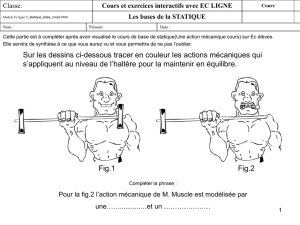
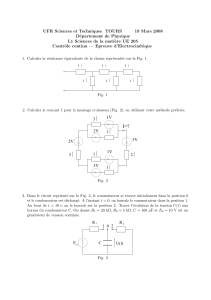
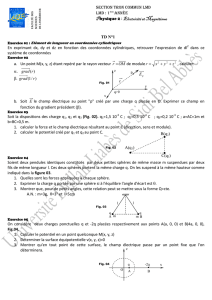
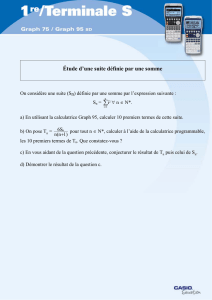
![III - 1 - Structure de [2-NH2-5-Cl-C5H3NH]H2PO4](http://s1.studylibfr.com/store/data/001350928_1-6336ead36171de9b56ffcacd7d3acd1d-300x300.png)
